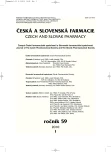Studies on local anaesthetics: Part 191 Optimization of the composition of hydrogels from the standpoint of flow properties for trimecaine and terbinafine
Authors:
P. Herdová 1; Z. Vitková 1; J. Čižmárik 2
Authors‘ workplace:
Univerzita Komenského Bratislava, Farmaceutická fakulta, Katedra galenickej farmácie
1; Univerzita Komenského Bratislava, Farmaceutická fakulta, Katedra farmaceutickej chémie
2
Published in:
Čes. slov. Farm., 2010; 59, 31-33
Category:
Short News
Overview
The study was concerned with the formulation of the local anaesthetic agent trimecaine and the antimycotic agent terbinafíne into hydrogels possessing the optimal flow properties. The gelling agents were the cellulose derivatives hydroxyethyl cellulose and hydroxypropyl cellulose. The evaluation included the samples in various combinations and concentrations prepared in such a way to produce the most suitable hydrogel viscosity with regard to the intended use. On the basis of the evaluation of the rheological properties, the suitable gelling base for the local anaesthetic trimecaine proved to be the combination of 1% trimecaine and 2% hydroxyethyl cellulose, and for the antimycotic terbinafíne, the combination of 1% terbinafíne and 3% hydroxypropyl cellulose.
Key words:
terbinafíne – trimecaine – cellulose derivatives – hydrogels – viscosity
Sources
1. AISLP – terbinafinum, Mikro-verzia AISLP – SR 2009.1 pre MS Windows.
2. Mincová, M.: Technologický reglement – Mesocain gél. závod Zentiva, a.s., Hlohovec, 2002, 11 s.
3. Rowe, R. C., Sheskey, P. J.: Handbook of pharmaceutical excipients. 5th ed. London: The pharmaceutical press 2006; s. 918.
Labels
Pharmacy Clinical pharmacologyArticle was published in
Czech and Slovak Pharmacy

2010 Issue 1
Most read in this issue
- On the content of the national section of the Czech Pharmacopoeia 2009
- Present-day approaches to pharmacotherapy – pharmaceutical care or drug management?
- Preparation and evaluation of hydrophilic cream with propolis extract
- Long-term trends in the utilization of beta-blocking agents in the Czech Republic
